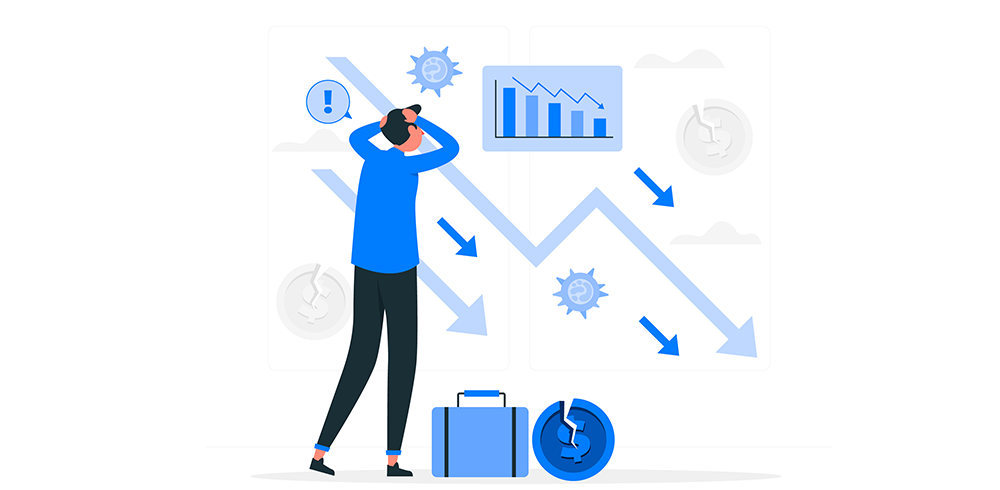In the world of banking and finance, non-performing assets, also called NPAs, are critical. Wondering why? Well, NPAs are the loans that borrowers still need to pay back and hence, they can cause problems for banks. Also, having unpaid loans can make it harder for borrowers to get loans in the future because it affects how trustworthy they seem to banks. In other words, it negatively impacts their creditworthiness.
So, let’s learn more about what is a non-performing asset, types of NPA, NPA recovery methods, and more.
What Is a Non-performing Asset (NPA)?
NPA’s full form in banking is Non-Performing Asset. As mentioned earlier, a Non-Performing Asset is a loan for which the borrower has stopped paying interest or principal repayments within the stipulated time frame. Now, when this loan isn’t paid back on time, banks would classify it as an NPA and consequently, take necessary actions to recover the dues.
How Non-performing Assets (NPAs) Work?
The process is simple to understand. When a loan is not paid back on time, it turns into an NPA, and then the banks start the process of recovering the unpaid dues. This can happen in many ways including contacting the borrower to restructure the loan terms, engaging recovery agents to collect payments, or selling the loan to asset reconstruction companies. Here, the goal for the bank is to minimise losses and restore the loan to performing status if possible. This would help in protecting the bank’s financial interests.
Types of Non-performing Assets (NPAs)
Here are the major types of NPA you must be aware of:Substandard Assets
These are loans where the borrower has failed to make payments for less than a year. When this happens, the banks classify these loans as substandard because there is still a chance of recovery.Doubtful Assets
As the name suggests, the loans classified as doubtful come under this category. They become doubtful when they remain unpaid for over a year. Banks are less optimistic about recovering these loans and may make higher provisions.Loss Assets
This is the third category where the loans are considered irrecoverable. Banks write off these loans as losses and take them off their books.
NPA Provisioning
NPA provisioning is the process where banks set aside provisions to cover potential losses from NPAs. The amount of provisioning depends on the classification of the NPA and regulatory guidelines. Provisioning is there to make sure that banks have sufficient funds to suffer losses and maintain financial stability.GNPA and NNPA
These are two sub-categories in non-performing assets.
- Gross Non-Performing Assets (GNPA): This is the total amount of NPAs before deducting any provisions made for potential losses.
- Net Non-Performing Assets (NNPA): This is the amount of NPAs after deducting the provisions set aside.
NPA Ratios
NPA ratios are important for banks as they are the indicators of a bank’s asset quality and risk management. The lower the NPA ratio, the better financial condition a bank has. This ratio compares NPAs to the total loans disbursed by the bank and helps stakeholders check the bank’s financial health and stability.
Example of NPA
An example of an NPA, a non-performing asset, could be a personal loan where the borrower, due to financial difficulties, stops making payments for over 90 days. This results in the loan being classified as an NPA, compelling the bank to initiate recovery procedures.
Impact of Non-Performing Assets
Non-performing assets impact the bank as well as the borrowers. In banking, NPAs affect a bank’s profitability and liquidity. In other words, it impacts the bank’s ability to support economic growth.
Now, borrowers with NPAs may face difficulties in obtaining credit in the future. It can also harm their credit score and financial reputation, and eventually affect their ability to secure loans at favourable terms.
NPA Recovery Methods
Already mentioned earlier, there are three NPA recovery methods. Let’s understand how they work:Restructuring
When NPA loans emerge, banks may renegotiate loan terms with borrowers to make repayment more manageable. It could be extending the repayment period or reducing the interest rate.Recovery Agents
Banks may also hire third-party recovery agents to collect overdue payments from borrowers through negotiation or legal action.Asset Reconstruction Companies
Here, the asset reconstruction companies purchase NPAs from banks at discounted prices and attempt to recover the debts by various means including restructuring or liquidation of assets.
Conclusion
Now that you know the significance of NPAs, make sure you always pay your loans and credit bills on time. It would not only help you in the long run but also positively impact the economic growth of the country by protecting the overall health of the banking system.
Now, if you are looking for an instant personal loan with top loan companies, CASHe is here to help you out. Download the CASHe app and explore personal loans, travel loans, medical loans, education loans, home renovation loans, and more to get the funds you need.
FAQs
1. What are Non-Performing Assets?
NPAs, or non-performing assets, are loans in which borrowers have stopped paying interest or principal repayments for a specified period, usually 90 days.
2. What Happens to Non-Performing Assets?
There are certain measures a bank takes when a loan is classified as an NPA. It includes restructuring loans, taking the help of recovery agents, or selling loans to asset reconstruction companies.
3. How Do Banks Deal With NPA?
Banks deal with NPAs by setting aside provisions for potential losses, restructuring loans, and employing recovery methods.
4. What is An Example of a Non-Performing Asset?
Suppose you avail a personal loan and then you stop making payments for 90 days or more due to financial difficulties. This is the time when the loan would be classified as an NPA.
5. What is a favorable NPA ratio?
The NPA ratio should always be lower, usually under 3%, as it tells about better asset quality and effective risk management by the bank.








